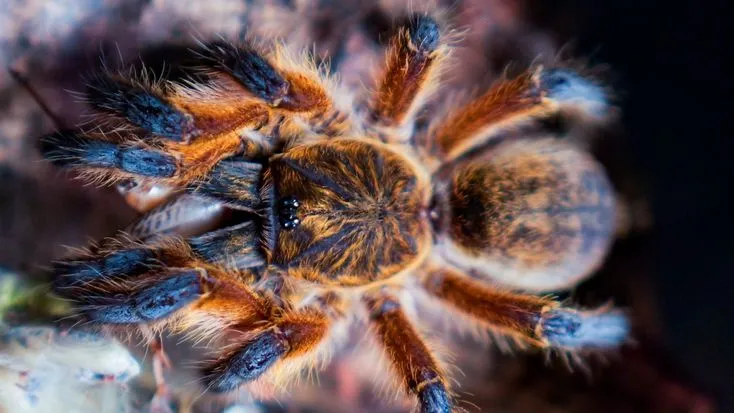What is the Blue Leg Tarantula?
The Blue Leg Tarantula, scientifically known as Coremiocnemis sp., is a captivating species of tarantula native to Australia. These spiders are highly sought after by enthusiasts due to their striking appearance and relatively docile nature. They are ground-dwelling spiders, meaning they live in burrows or under objects on the forest floor. Their vibrant blue legs, contrasted against a dark body, make them a favorite among tarantula keepers. While not as commonly encountered as some other Australian wildlife, the Blue Leg Tarantula holds a special place in the hearts of arachnid lovers.
Appearance and Characteristics of the Blue Leg Tarantula
The Blue Leg Tarantula’s most distinguishing feature is, of course, its vibrant blue legs. This coloration varies slightly depending on the individual and their stage of development, but generally, the legs display a stunning iridescent blue hue, which often reflects in sunlight. The carapace (the top part of the cephalothorax) and abdomen are typically a dark brown or black color, providing a beautiful contrast to the legs. These spiders are medium-sized, with a leg span that can reach up to 6 inches. They possess the characteristic hairy bodies typical of tarantulas, which help them to detect vibrations and navigate their environment.
Habitat and Distribution of Blue Leg Tarantulas in Australia

Blue Leg Tarantulas are primarily found in the rainforests and moist woodlands of northern Australia. Their distribution is somewhat localized, but they can be found across several states. These tarantulas prefer environments with high humidity and abundant leaf litter, which provides both shelter and a suitable habitat for their prey. The specific locations where they are most commonly observed include areas with dense vegetation and access to a reliable water source. Their distribution is a testament to the unique ecosystems found in the Australian tropics and subtropics. It is a marvel to find them thriving in these beautiful, lush habitats.
Where do Blue Leg Tarantulas live?
Blue Leg Tarantulas live in burrows or under objects like logs, rocks, or dense vegetation. These burrows provide them with protection from predators and the elements. They often line their burrows with silk to create a secure and comfortable environment. These spiders are typically found on the forest floor, where they hunt for their prey. Understanding their habitat requirements is crucial for conservation efforts, as habitat loss poses a significant threat to their survival.
What is the best way to spot one?
Spotting a Blue Leg Tarantula in its natural habitat requires patience and a keen eye. They are masters of camouflage and often remain hidden during the day. The best time to look for them is typically at dawn or dusk when they may be more active. Look for signs of their burrows, such as a small hole in the ground, or silken webs leading into a burrow. Slow and careful movement is key, as tarantulas are sensitive to vibrations. It’s crucial to respect their space and avoid disturbing their habitat. If you are lucky enough to spot one, appreciate the moment from a safe distance, as these spiders can bite if threatened.
Unique Behaviors of the Blue Leg Tarantula

Blue Leg Tarantulas exhibit a range of fascinating behaviors. They are primarily nocturnal, meaning they are most active at night. This is when they emerge from their burrows to hunt. They are ambush predators, waiting patiently for unsuspecting prey to come within striking distance. When threatened, they may flick urticating hairs from their abdomen as a defense mechanism. Additionally, they are known to be relatively docile compared to some other tarantula species, making them a popular choice for tarantula enthusiasts. They are masters of their environment and an excellent example of adaptation.
Diet and Hunting Habits of Blue Leg Tarantulas
Blue Leg Tarantulas are carnivores, with a diet consisting mainly of insects and other invertebrates. Their diet varies depending on the availability of prey in their habitat. They are opportunistic hunters, meaning they will eat whatever they can catch. Their hunting strategy involves remaining motionless until an unsuspecting prey item comes within range, at which point they launch a swift attack. They inject venom into their prey, which both immobilizes and begins to digest the prey from within. They then consume the liquefied contents, leaving behind the exoskeleton.
What do they eat?
The Blue Leg Tarantula’s diet consists of various insects and invertebrates. Commonly consumed prey items include crickets, cockroaches, mealworms, and other small bugs found on the forest floor. In captivity, they can be fed a similar diet of commercially available insects. A varied diet is essential for maintaining the health and well-being of these tarantulas. Ensuring the prey items are appropriately sized is also crucial to prevent the tarantula from being injured or stressed. The diet is a critical factor in their survival and health.
How do they hunt?

Blue Leg Tarantulas are ambush predators. They typically sit and wait, often near the entrance of their burrow, patiently waiting for prey to come within striking distance. When an insect or other invertebrate comes close, they quickly pounce, injecting venom to paralyze their prey. They use their fangs to inject venom and then use their chelicerae (mouthparts) to crush and manipulate their meal. This hunting strategy allows them to conserve energy and efficiently capture prey in their natural habitat. They are built for this type of hunting.
Conservation Status and Threats to Blue Leg Tarantulas
The conservation status of the Blue Leg Tarantula is not officially listed, but there are concerns about habitat loss due to deforestation and urbanization. These threats can lead to a decline in their population. The pet trade, while not a major threat, can also impact populations if not managed sustainably. Raising awareness and promoting responsible practices are crucial for protecting this fascinating species. Conservation efforts should focus on preserving their natural habitat and educating the public about their importance in the ecosystem.
Are they endangered?
While the Blue Leg Tarantula is not currently listed as endangered, there are ongoing concerns about the sustainability of their population. The main threats to their survival include habitat loss and degradation. Changes in land use and climate change can significantly affect their habitat, and can decrease the chances of survival. Conservation groups continue to monitor population levels and advocate for the protection of their habitats to prevent them from being endangered in the future. Protecting their habitat is the most important factor.
What are the threats to them?

The primary threats to the Blue Leg Tarantula include habitat loss and degradation due to deforestation and urbanization. Climate change may also have an impact. As the habitat changes and becomes less suitable, their populations can be negatively affected. Unsustainable collection for the pet trade could also pose a threat. Other threats include the use of pesticides, which can contaminate their environment and impact their prey. Protecting their natural habitat and implementing conservation measures are crucial to ensuring their survival.
Caring for Blue Leg Tarantulas in Captivity
Caring for a Blue Leg Tarantula in captivity requires careful attention to their needs. They require a terrarium that is appropriately sized for their leg span, with a substrate of coco fiber or peat moss to allow them to burrow. Maintaining the correct humidity levels is also essential. The terrarium should be kept at a temperature between 75-85°F (24-29°C), with a slight temperature drop at night. Provide a shallow water dish for drinking. They should be fed a varied diet of insects, such as crickets and cockroaches, and the uneaten prey should be removed to prevent the build-up of waste. Handle them with caution, as they can bite if they feel threatened. Always provide a safe enclosure to keep the tarantula safe and comfortable.
Conclusion
The Blue Leg Tarantula of Australia is a remarkable species. These spiders are a fascinating part of Australia’s biodiversity. From their stunning appearance to their unique behaviors and needs, the Blue Leg Tarantula captivates all who study them. By understanding their habitat, behavior, and the threats they face, we can work to protect these amazing creatures for future generations. Whether encountered in the wild or admired in captivity, the Blue Leg Tarantula continues to be a source of wonder and intrigue, and deserves our respect and protection.
